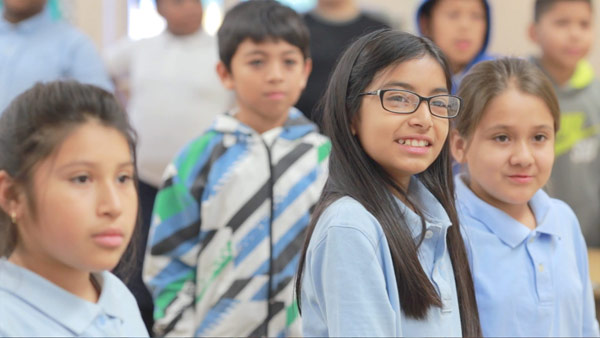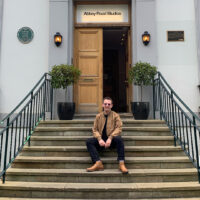
Music Classes Bridge Academics With Creativity
By Max Kapur
“Can anyone guess what this word might mean?” Rose Campion, a senior at USC Thornton, holds up a cube with music terms written on each side and pointed to one: forte. A few students shout out a guess: “Strong!”
“It looks like Spanish, doesn’t it?” Campion asks. “And you’re right. Forte is the Italian word for ‘strong,’ and in music, when we say forte, that means to play or sing loudly.”
The cube is a teaching device that helps fourth graders in Campion’s Adventures in Music class understand the three dimensions of musical sound. Each set of opposed faces forms a complementary pair, like forte and piano for loud and soft. Campion rotates the cube and has her students demonstrate high and low pitch, and fast and slow tempos.
It’s an effective device for teaching music terms, but it also compliments what the students are learning in their math and English classes: how the six directions fit into three-dimensional space and how most adjectives have opposites.
At a time when many schools are pushing music and arts programs to after-school and weekend schedules, the success of the USC Thornton’s Community Engagement Program makes a case for music’s importance in a well-rounded academic curriculum.
“Math skills are enhanced in music education. They’re using logic,” said Kevin Dempsey, principal of the St. Agnes School. He’s welcomed Thornton’s choir and general music programs year after year. “We’re an under-resourced school,” he said. “The Thornton program preps them, gets them excited and keeps music alive in them.”
Indeed, USC Thornton’s programs encourage students to embrace the attitude that learning is a continuous process and not a set of hurdles. In programs like Adventures in Music, they can track their strengths and weaknesses and improve one area at a time through steady practice.
“Some students don’t even realize that they have musical talent. Because they’re exposed to it, they start developing this love for music,” said Monica Garcia, whose fourth-grade class at St. Agnes took part in the Community Engagement Program’s choir festival. Garcia said that as the year went on, students began to sing their music on their own at recess and lunch. They organized their own practice groups and exchanged tips on their technique. And in their other school subjects, they began to demonstrate a sharper eye for detail and greater willingness to push through tough problems.
Malika Morris, a fourth-grade teacher at Vermont Elementary, agreed. She said that in music class, students who feel out of place in their academic school subjects learn to feel at home at school. “[Music] teaches to the different modalities that kids may have,” she said. “All kids may not necessarily be visual learners. There might be kids who are auditory students as well.”
Campion, whose cube helps students visualize opposite terms, explained that her mission as a music teacher goes beyond providing students with a creative outlet.
“It’s important for kids to learn music not just for the notes and rhythm,” she said. “It’s about teamwork, building their self-confidence.”
Each Wednesday this November, we showcase the incredible impact that USC Thornton’s Community Engagement Programs are having on local schools.


